Introduction
Environmental conditions in ecosystems change, fire flood, cyclone and drought may cause widespread changes that have both short term and long term consequences. Introduced animals change relationships within ecosystems.
Sustainable ecosytems
Ecosystems that are diverse and are able to provide the needs of the organisms living there over a long period of time are sustainable ecosystems.
In sustainable ecosystem there are a wide variety of species. Species refer to different types or organisms (living things). There are many different habitats for these species. most have a variety of food sources, so if one food source is in short supply they can use another.
Natural ecosystems are sustainable. When humans interfere with the ecosystem they can change the ecosystem. This can result in unsustainable environments.
Traditional use of fire
Fire causes rapid changes in ecosystems. Fire has been important part of Australian ecosystems. Many plants have adapted to fire. some plants need fire to release seeds from woody seed pods. Other plants recover quickly after fire has destroyed their leaves. Indigenous Australians use fire as a tool for hunting. Animals escaping from fire could be captured more easily by hunters. They tended to use frequent cool fires.
Forests were replaced b open woodlands and grasslands. This led to an increase in grazing animals such as kangaroos.
Fuel reduction burning
Fires use fuel to burn, these fuels include twigs and bark from trees. Regular burning means that the fuels are used up and do not build up. If there is too much time between fires the amount of fuel available increases. This leads to more intense fires which incinerate animals and plants.
Fire monitoring technology
Different parts of Australia have different times of the year when fires are most likely to occur. These times are known as the fire season. Scientists have developed a system called Moderate Resolution Imaging Spectroradiometer (MODIS) sensors.
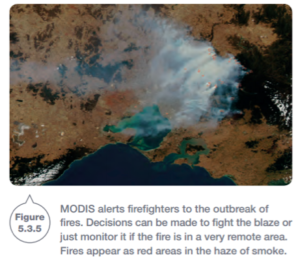
This helps firefighters identify fires. Emergency agencies can then decide how best to use their resources to fight the fires effectively. Less than an hour after the observations are made using MODIS, the Water and Land division of CSIRO has a picture of the location and intensity of fires.
Floods
Floods change ecosystems. The usual image of Lake Eyre is of a dry bed of salt surrounded by desert. When water reaches the lake, a completely different ecosystem is established. After remaining in the sand for years, the seeds of wildflowers germinate producing large areas of color.
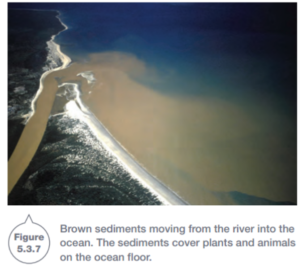
Flood plains
Flood plains are areas along the banks of rivers and streams that are flooded when water levels are high.
Many Australian cities and towns are built on flood plains because in the past, transport by boat was easy, and it was also easy to get water and to dispose of wastes. An example is Gundagai (NSW), shown in Figure 5.3.8. Flood plains are also fertile and good for growing food crops. Regular flooding adds nutrients and moisture to the soils but also means that the towns and businesses are damaged.
As towns have increased in size, flood damage has increased. Floods such as the one that swamped Moree (NSW) in 2012 (Figure 5.3.9) cannot be prevented, but they can be managed to some extent.
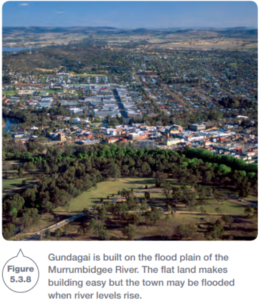
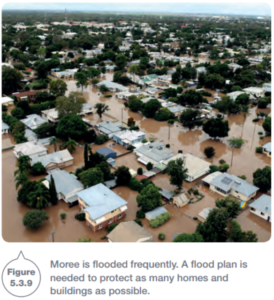
Any plan to manage the flood plains should consider different aspects of the situation.
- There are natural ecosystems on the flood plains that need to be conserved.
- People must still be able to live and work in the area without risking their lives or health.
- When a flood occurs, the cost of property damage should be kept to a minimum.
Flood management
Flood management can take different forms.
- raised banks called levees can be built to prevent water reaching buildings.
- Channels can be dug to carry the water away more efficiently
- The use of the land takes into account the risk of flooding the area
- pumps for water supply and sewage treatment are in areas that do not flood
- Buildings are constructed with floor levels above flood levels.


When floods occur they are not all the same height. Regional councils have flood maps drawn that show how likely it is that particular areas will flood. Using these maps, decisions can be made about the use of the land. For example, essential services such as hospitals, telephone exchanges and flood coordination centres should be placed in areas least likely to flood. Natural ecosystems could be maintained in the areas most likely to flood, or these areas could be used for playing fields and open space.

Introduced species
Many species of plants and animals have been introduced into Australia. These include:
- most of the animals and plants we use as food
- pet animals such as cats and dogs
- animals used for transport and recreation such as the horse and the camel
- many ornamental plants used in parks and gardens such as the jacaranda.
The wool, cotton and leather used to make clothes and furnishings come from introduced species. The majority of the introduced species have benefited humans. The same is not true for other introduced species such as the fox.
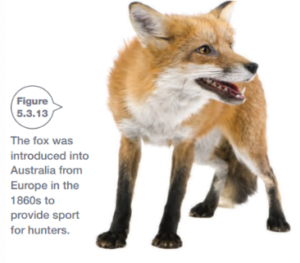
Animal control
Native animals such as dingoes kill lambs for food. Farmers build fences to protect their animals. introduced animals such as rabbits compete with cattle and sheep for fodder.
Dingo fence
Dingoes were a problem for farmers in the late 1800s. Between 1880 and 1885 a fence was constructed to protect the sheep of southern Queensland from attack by dingoes. The path followed by the fence. The aim of the fence was to keep the dingoes out of the fertile areas of south- eastern Australia. The fence has brought benefits and disadvantages. The advantage is that fewer sheep are killed and eaten by dingoes. Also the numbers of emus and kangaroos are greater where there are no dingoes. The disadvantage is that the greater numbers of kangaroos and emus inside the fence compete with the sheep for the grass.This means that farmers cannot graze as many sheep per hectare.
Wild camels are damaging the dingo fence. Plans are in place to build a taller fence that is electrified.

Rabbit-Proof fence
Rabbits were introduced to Australia with the arrival of European settlers. Rabbits were damaging crops and eating all the grass, leaving nothing for cattle to feed on. By digging their burrows rabbits were causing millions of dollars worth of damage to grazing land.
The rabbit-proof fence was built to protect crops and grazing land in Western Australia. There are 3 parts that make up the rabbit-proof fence. They stretch a total of 3253 kilometers. It is the largest unbroken fence in the world.
The rabbit proof fence brought other benefits too. It has protected the livelihood of farmers by excluding dingoes, emus, foxes and feral goats. It also creates a 20m wide fire break along its total length
The myxoma virus
In the 1950s a virus, the Myxoma virus, was introduced into the rabbit population. Large numbers of rabbits died and the importance of the fence was reduced.





